Pomegranate Fruit Uses, Recipes and Storage From the University of Florida, Institute of Food and Agricultural Sciences, Volusia County Extension and wikihow.com Pomegranates are an ancient fruit with many delicious uses. When looking for pomegranates to eat at home, here are a few things to be aware of. 2  Fig. 1 Look for pomegranates that feel heavy for their size. 2 Once a pomegranate is picked it stops ripening but develops more flavor in storage. Select fruit that are weighty for their size with taut, glossy, unbroken skin. 1 The skin color should be red or yellow. 2 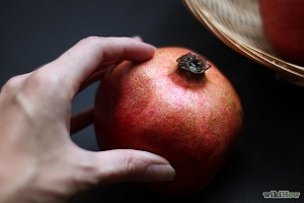 Fig. 2 When ripe, the outer skin of the pomegranate becomes soft and can be scratched under gentle pressure. The shape changes with the sides becoming slightly squared; it will look flattened on the sides. As the seeds or arils as they are called reach their maximum juice content, they press against the outer wall and cause the sides to flatten. Pomegranate color ripens to a deep red shade on the outside. Before ripening, the skin is hard, tight and cannot be easily scratched. Unripe pomegranate fruit is round in shape much like an apple. It is considered ready for harvest when the fruit makes a metallic sound when tapped. If the fruit becomes over-mature, it tends to crack open if rained upon. 1 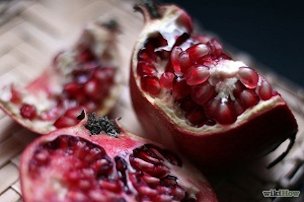 Fig. 3 If there is a cut pomegranate on display, check out the seeds. The juicier the seeds appear, the fuller the flavour of the pomegranate. The seed color will vary from ruby red to pale pink. 2 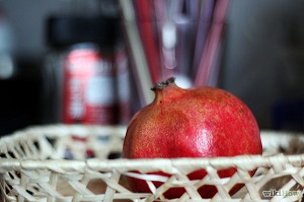 Fig. 4 Pomegranate keeping quality is similar to that of apples. They should be kept in a cool, dry, well-ventilated place, out of direct sunlight. Whole fruit can be refrigerated and will keep as long as 2 months. Fresh seeds or juice will keep in the refrigerator for up to 5 days. 1 Consume a cut pomegranate within four days. You will find that the flesh deteriorates quickly once the fruit is opened. 2 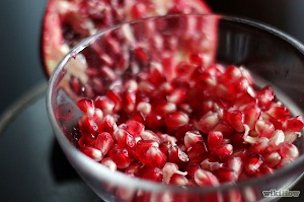 Fig. 5 How to Extract Arils Begin with plastic gloves and an apron, pomegranates are messy! Cut off the crown end and score vertically into several segments. Place pomegranate in a bowl of water, carefully break segments apart, and separate arils from the wall of the fruit. Arils will sink while peel floats. Skim unwanted peel from top of water and drain arils in a colander. 1 Pomegranate arils can be frozen for later use. To freeze, spread the arils, single layer, on a baking sheet lined with wax paper. Put them in the freezer for no more than 2 hours, then transfer to a moisture, vapor-proof freezer bag or container for storage. Return to the freezer and use within one year. 1 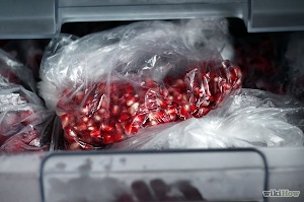 Fig. 6 The juice can be frozen or canned, however freezing is recommended as it maintains its flavor and color better. To freeze, fill freezer containers, leaving ½ inch headspace. Label with the date and store in the freezer in an upright position until juice is frozen. Best if used within one year. 1 Fruit Uses The edible portion of the fruit includes the seeds and the juice-filled sacs that cover them. They can be used as a garnish in fruit cups, compotes, salads, desserts, and as a snack. The juice is used to make jellies, puddings, desserts, and drinks. Grenadine is made from pomegranate juice and is used as a flavoring for some beverages. Grenadine is a delicious topping for chilled fruits or ice cream. Additionally, dried pomegranates seeds and juice sacs are available as spices in specialty stores. 1 For recipes, visit www.crec.ifas.ufl.edu/extension/pomegranates/recipes.shtml Other Uses Peel: tooth powders, toothpastes, facial care products, coughing remedies, supplement in cow feed. Trunk Bark: tannins used to cure leather, in making insecticides, alkaloids are active against tapeworms. Rind and Flowers: yield dyes for textiles, used to reduce oral and throat inflammation, buds used to treat bronchitis. Leaves: mixed with vinegar to make ink. Fruit: extracts used as astringents, fruits used in ornamental decorations. Wood: used for walking-sticks and in woodcrafts. 1 Back to Pomegranate Page |
|
| Bibliography 1 Bryant, Kathleen M. "Pomegranate Fruit Uses, Recipes and Storage." Family and Consumer Sciences, University of Florida/IFAS Volusia County Extension. Last modified 7 May 2013, 19 June 2018, UF/IFAS Citrus Extension, crec.ifas.ufl.edu/extension/pomegranates/recipes.shtml. Accessed 9 Aug. 2014, 21 Nov. 2018. 2 "Select and Store Pomegranates." wikihow.com. Accessed 9 Aug. 2014. Photographs Fig. 1,2,3,4,5,6 "Select and Store Pomegranates." WikiHow, wikihow.com. Accessed 9 Aug. 2014. Published 9 Aug. 2014 LR. Last update 21 Nov. 2018 LR |
|